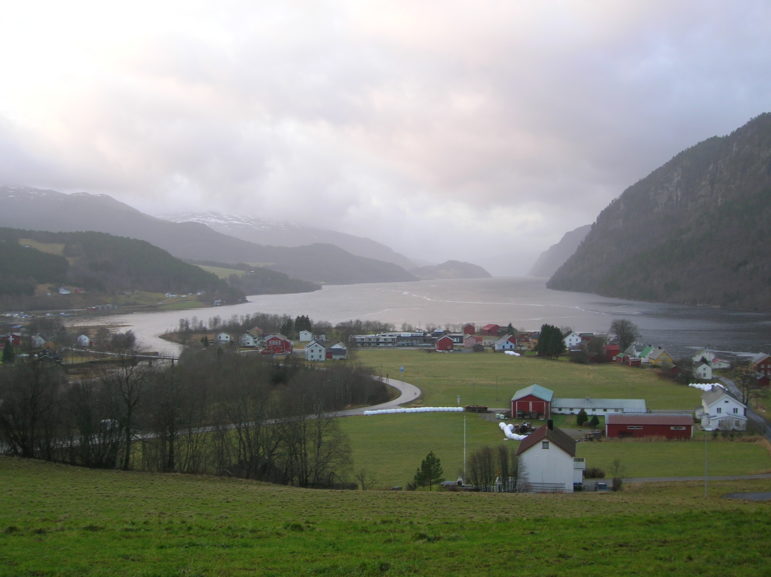VINJEØRA, Norway – Archaeologists have found the remains of a “mortuary house” from the Viking age. Vinjeøra is in central Norway, 377.7 km (234.7 miles) northwest of Oslo. When a house-like structure functions as a coffin to indefinitely contain a corpse, people label it a “mortuary house.”
In Norway, Pagan Viking culture lasted throughout the Viking age, from 750 to 1050 C.E. As such, this mortuary house would have materially expressed Norse Pagan beliefs and practices about death.

Briangotts [CC BY-SA 3.0 (https://creativecommons.org/licenses/by-sa/3.0)]
Regional differences in Norse Paganism, Vinjeøra is in the purple area, near the North Sea – Image Credit: Briangotts [CC BY-SA 3.0 (https://creativecommons.org/licenses/by-sa/3.0)
Erosion, farming, and organic decay have destroyed most of the organic material from this site. Archaeologists have found the remains of a rectangular structure at the center of a circular depression called a ring ditch. Those ditches frequently surround burial mounds, common among the Norse. Archaeologists, however, have failed to find the occupant of this grave.
The rectangular structure measures roughly 5 by 3 meters (roughly 16 by 10 ft.). Postholes occupy each of the four corners. Flat stones connect each of the postholes. Unlike the 14 other known mortuary houses, this one sits in the center of a ring ditch and burial mound.
Many types of funerary practices co-existed
In Norway, seasonal weather limits funerary practices. In August, people can dig graves with relative ease. In January, the ground has frozen and the sun shines for fewer hours.
Ground burials, cremations, ship burials, and house burials all coexisted. Similar to mortuary houses, ship burials refer to entombment on land in a ship-like structure. Both mortuary houses and ship burials required a modest amount of resources.
At present, no one knows why the Vikings buried some people in ship-like structures and others in mortuary houses. Archaeologists have found the bodies of two women in ship burials. That finding would exclude a gender-based pattern: males buried in ships and females buried in houses.
Vikings buried some people in flat graves with no burial mounds. They buried the cremated remains of a person in urns. No evidence exists that burial or cremation depended on social or cultural differences. It is plausible, but highly speculative, that cremations would have occurred in the winter and burials in the summer.
Video interview with the lead archaeologist
The lead archaeologist on this project, Raymond Sauvage, took part in a YouTube Video interview. While not exactly the same as a peer reviewed journal, the interview has a credible source, made modest claims, and avoided sensationalism.
According to Raymond Sauvage, lead archaeologist, no one has found evidence for the highly cinematic burning-boat sailing out-to-sea cremation ritual. In addition, Sauvage argued that boats would be too valuable a resource to use in this manner.
Sauvage reported that archaeologists have found about 30 graves at this site. They also found flat grave burials, cremations, ship burials, and two mortuary houses. They will excavate the second mortuary house in 2020.

Village of Vinjeøra – Image credit: Kasschei – Own work, Public Domain, WikiCommons
Fearing and venerating the dead at the same time
No one knows with certainty the meaning of mortuary houses to the Vikings. Sauvage suggested that passing the threshold of the mortuary house would mark the transition from biological to social death.
Sauvage said one line of further research would be to study the sagas, Eddas, and myths. Those texts could contain some reference to the mortuary house or something like it. In particular, he referred to the Norse myth of the “draugr,” an undead creature with an envy of the living. These liminal and dangerous creatures are unaware if they are dead or alive. They do pose a danger to humans.
Sauvage felt a connection existed between the draugr and several Norse Pagan beliefs. When someone died in a structure, they would take the body out through the window. The Norse did so to confuse the recently dead and prevent their return to the structure to cause harm.
Norse Pagans believed that the living should propitiate the dead. If the living failed to do this, the dead would enter the world of the living and cause chaos. Acting on this belief, Vikings would and bring food and gifts to the burial mound. They might then commune with the dead. It can be difficult to distinguish between acts of love and offerings to propitiate.
These myths suggest that mortuary houses and ship burials would trap the dead to keep them nearby and to protect the living.
The Norse feared and venerated the dead at the same time. The burial mound could have expressed those conflicting aspects. The dead would be both honored and contained, present but separated from the living.
This mixture of veneration and fear might seem strange to people today. Many modern people have contradictory feelings towards significant people in their lives. Moderns express those contradictory feelings in support groups, therapist’s offices, and 12-step meetings. Maybe the Vikings expressed their contradictory feelings in funerary practices.
The Wild Hunt is not responsible for links to external content.
To join a conversation on this post:
Visit our The Wild Hunt subreddit! Point your favorite browser to https://www.reddit.com/r/The_Wild_Hunt_News/, then click “JOIN”. Make sure to click the bell, too, to be notified of new articles posted to our subreddit.
